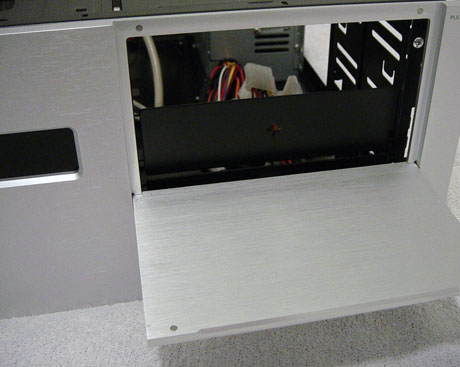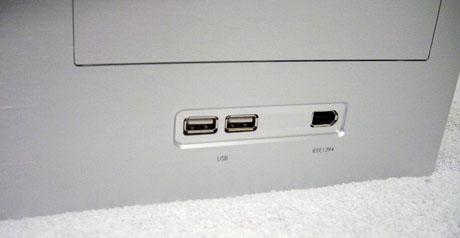A First Look at the HTPC Case Genre with the Ahanix D.Vine 4
by Purav Sanghani on October 10, 2004 1:00 PM EST- Posted in
- Cases/Cooling/PSUs
External Design
When looking at an audio/video enthusiast's playground, the first thing that we notice is the array of components on shelves or in closets. Each component has an important role in the entire system, technologically, but we also notice that each component is designed in a similar manner. Looks are not always a huge factor when choosing a home theater component, but when moving into the realm of PCs and PC cases, looks become as important as what is inside the system.Many home theater enthusiasts not only go for the quality of the sound and video being produced by their equipment, but also how each component will look in their setup, especially when dropping a few grand into their new toys. This is where the outer shell of an HTPC case can make a world of difference.
All of the case manufacturers that have tapped into the HTPC case market have their own style in looks. As time goes on and the variety of HTPC cases grows, it will become much easier to match certain cases with home theater components. For example, Ahanix's D.Vine 4, which we will be looking at in this article, comes in black and silver, which expands its compatibility, visually, among a wider range of brand name components. Sony's ES series of home theater receivers, as an example, comes in a silver finish and features a small display much like Ahanix's VFD (Vacuum Florescent Display), which is located at the center of the bezel.
The D.Vine 4 series of HTPC cases has an all-aluminum bezel that is about 8mm thick. There is a power and reset button on the bottom left, which are colored silver. Above the larger power button is the blue power LED, which gives the face a cool blue and silver theme.
The right side of the bezel consists of a fold-down aluminum door that covers the two exposed 5-1/4" drive bays. The door is well secured to the bezel by magnets and requires a firm pull to release it.
Below this area are the auxiliary USB and FireWire ports. The audio (headphone out and microphone) ports are missing from this case, since it will be sitting with the other components and not within wires reach. HTPC cases are usually connected to the audio equipment of the theater system.














21 Comments
View All Comments
rafaelaustin - Friday, October 29, 2004 - link
Heat and noise are the enemies of an HTPC. The temperatures displayed in this test seem exceptionally low for what I've seen reported by others, usually around 55c. Try this with an Intel CPU or a "slimline" case and see what happens. The 520W Powerstream is overkill. Also, where is the TV tuner? It needs a Hauppauge PVR-250 to make this a real HTPC.rafaelaustin - Friday, October 29, 2004 - link
geogecko - Wednesday, October 20, 2004 - link
When can we expect to see a more comprehensive review of HTPC cases?Some interesting units out there on the net that would be good choices for review, IMO:
http://www.atechfabrication.com/
http://www.ahanix.com/ (other newer options)
http://www.silverstonetek.com/
And especially the new HT-400 from:
http://www.kanam.co.kr/
Bochista - Wednesday, October 13, 2004 - link
My recent purchase of an HDTV puts me in a position where an HTPC would be useful, but I don't think some of the things I intend to do are considered in this review. Some things were hit on however, and I hope to see more cases with these features.1. I need LOTS of storage. Archives of my HD Tivo will take up quite a bit of room.
2. I want to play games on my 62 inch TV, so I need thermals for serious video cards as well.
3. The IR reciever for remote is nice.
4. The ability to have an LED panel acknowledge commands from the remote, display track/time of a movie etc. Also, the ability to dim during movie watching so as to be less of a distraction.
5. Silent Cooling.
pshrink - Wednesday, October 13, 2004 - link
"Another feature that Ahanix has managed to implement, and others should follow suit, is the IrDA transceiver"I can't see anything like a IrDA transceiver in the pictures, and I can't find any info on Ahanix's web site with regard to built-in IrDA capability. Someone please clarify.
tagaste - Wednesday, October 13, 2004 - link
Amen. Why make it seem like the temperatures are a problem when they aren't? They aren't even close. Perhaps the review has to appear 'balanced' but surely perfectly normal operating temperatures shouldn't be given anything like the same weight as ease of access, noise levels, and aesthetic considerations. When normally-clocked HTPCs actually start failing because of heat from poor ventilation or Johnny burns his hand on the case, then it's time to talk about "thermal issues."iwilson - Tuesday, October 12, 2004 - link
The thermal testing is nonsense. An HTPC places noise control a lot higher in importance than thermal load. The temps quoted are nowhere near the level of causing a problem with any of the components. My HTPC has run for several years with less fans than in the article with absolutely no problems. As long as the PC is stable I couldn't care less if the temperature was 500 degrees inside.Case I use is here btw http://www.kanam.co.kr/html/htpc.htm
Bookie - Monday, October 11, 2004 - link
I'm glad you guys are spending more time with the htpc market. I'd like to see a review of silverstone's htpc case. I'm getting ready to drop a lot of money on a new entertainment system (plasma, htpc, and the works), and just want to make the right decision. I'm very interested in the lc02 (black: http://www.silverstonetek.com/products-lc02.htm) with a matx setup, but all the reviews I've read try to fit a full sized mb with all the xtras (unecessary if you ask me). I think that something like this with a mobile processor (mobile athlon 35watt probably) would be the best setup.CrabbyGuy - Monday, October 11, 2004 - link
I think that AnandTech's thermal tests very much need expansion for HTPC cases. Very few people will build a PC in a case like this and then leave it freestanding. Rather, HTPCs will be stacked on (or even under) other home theater components and are likely to be installed in cabinets closed at the rear without fans in many living rooms. Testing the cases' thermals in these situations would be very helpful to many of us. Also, recommendations such as, "Put a fan pulling at least 25CFM behind the right-hand side of the case when installing in a closed cabinet and do not operate an HTPC installed in this case without its being open at the front," would seem especially useful. The alternative is either trial and error or component failure for many users.CrabbyGuy - Monday, October 11, 2004 - link